
Solar power is leading the charge. In 2024, global solar electricity generation alone could have powered an entire country the size of India. The EU, in particular, stands out for its clean energy progress, generating 71% of its electricity from low-carbon sources—including nuclear—last year. Nearly half of that came from solar, wind, and hydro.
"Europe has cemented a global leadership in clean power," said Dr. Beatrice Petrovich, a senior analyst at Ember. She adds that the continent is offering a global blueprint for scaling renewables, especially solar, across diverse conditions.
In the EU, solar generation almost doubled between 2021 and 2024, reaching 11% of total electricity—surpassing coal for the first time. Seven EU countries now rank among the top 15 globally for solar power share, making the bloc what Ember calls a "solar superpower." Germany was sixth globally in absolute solar generation with 71 TWh, while Hungary led in solar share at 25%, thanks to a now-expired residential solar incentive.
Spain saw the EU's biggest year-on-year increase in solar output, adding 10 TWh in 2024. Still, China remained dominant, responsible for more than half of global solar growth—an astounding 834 TWh of solar power last year, or 53% of the global increase.
Yet despite record clean energy gains, emissions from the power sector also rose to a record 14.6 billion tonnes of CO₂. This paradox was largely driven by surging demand for cooling during record heatwaves, highlighting the urgency of accelerating the clean energy transition.
The report also warns of continued challenges. Global electricity demand is projected to rise further as AI, electric vehicles, and heat pumps become widespread. But according to Ember, clean energy growth is still outpacing this rising demand.
Looking ahead, experts point to the U.S. state of California as a possible roadmap for Europe's next phase. In 2024, California met 20% of its evening peak electricity demand with batteries charged earlier in the day—a dramatic leap from just 2% three years prior. Similar shifts are expected in Europe, where countries like Ireland are beginning to scale battery storage.
To fully unlock clean energy's potential, experts emphasize the need for smarter electricity grids, better energy storage, and policy tools that reward consumers for aligning their energy use with renewable availability—like charging EVs during the day instead of overnight.
The energy crisis triggered by Russia's 2022 invasion of Ukraine has also spurred renewable adoption in Europe, reframing clean energy as not only a climate solution but also a security measure. "Renewables are now seen as a defense strategy," Petrovich notes.
Central and Eastern European countries are poised to play a bigger role in solar and battery development, while wind power—already providing 18% of EU electricity—is expected to expand thanks to faster permitting and better weather conditions.
Despite geopolitical and environmental uncertainties, the report concludes that the world's clean power systems are ready to meet the moment.